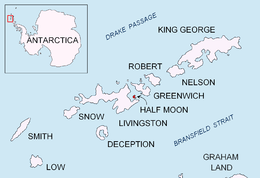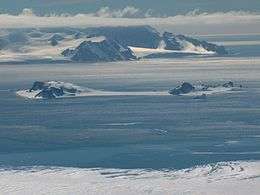Xenia Hill
Xenia Hill is the rocky hill rising to 96 m in the northeast extremity of Half Moon Island in the South Shetland Islands, Antarctica. It surmounts McFarlane Strait to the north and east, and Menguante Cove to the south-southeast. The area was visited by early 19th century sealers operating from nearby Yankee Harbour.



The feature's name appeared in a 2000 publication following Argentine ornithological research on the island, and in the 2005 and 2009 Bulgarian maps of Livingston Island.
Location
The hill located at 62°35′05.1″S 59°54′54.8″W which is 690 m northeast of Gabriel Hill, 7.03 km southeast of Edinburgh Hill, Livingston Island, 7.88 km south-southwest of Triangle Point, Greenwich Island and 10.46 km west-southwest of Ephraim Bluff, Greenwich Island (Bulgarian mapping in 2005 and 2009).
Maps
- L.L. Ivanov et al. Antarctica: Livingston Island and Greenwich Island, South Shetland Islands. Scale 1:100000 topographic map. Sofia: Antarctic Place-names Commission of Bulgaria, 2005.
- L.L. Ivanov. Antarctica: Livingston Island and Greenwich, Robert, Snow and Smith Islands. Scale 1:120000 topographic map. Troyan: Manfred Wörner Foundation, 2009. ISBN 978-954-92032-6-4
- Antarctic Digital Database (ADD). Scale 1:250000 topographic map of Antarctica. Scientific Committee on Antarctic Research (SCAR). Since 1993, regularly updated.
- L.L. Ivanov. Antarctica: Livingston Island and Smith Island. Scale 1:100000 topographic map. Manfred Wörner Foundation, 2017. ISBN 978-619-90008-3-0
References
- Cesar Garcia Esponda, Nestor Coria & Diego Montalti. Breeding birds at Half Moon Island, South Shetland Islands, Antarctica, 1995/96. Marine Ornithology, 2000, 28, pp. 59–62.